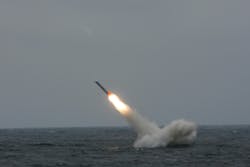Navy eyes open-systems, modular, and affordable nuclear cruise missile for Virginia-class attack submarines
WASHINGTON – U.S. Navy weapons experts are asking industry to develop a nuclear-tipped cruise missile to enable Virginia-class attack submarines to hold critical adversary targets at risk, and to deliver proportional response to enemy attacks.
Officials of the Strategic Systems Programs office in Washington has issued a request for information (N00030-RFI-SLCMN01) for the Nuclear-Armed Sea-Launched Cruise Missile (SLCM-N) development program.
Attack submarine deployment
From industry, Navy officials want to identify interest and resources in developing the SLCM-N nuclear cruise missile for Virginia-class boats using mature technologies, existing capabilities, and new approaches to reduce development time and procurement costs.
The Navy wants information on weapon system integration, cruise missile prototype development, and cruise missile subsystems, and to understand industry's ability to develop a prototype and integrate a deployable nuclear cruise missile.
The SLCM-N missile will consist of an expendable booster, a separating cruise missile from the booster, with a nuclear warhead in a canister to enable underwater launch from Virginia Payload Tubes or Virginia Payload Modules.
The missile should use an open-systems architecture and be as modular as possible in hardware and software such that changes to the core missile body or common tactical systems do not require changes to the warhead payload interfaces or avionics.
Open systems, modular, affordable
This approach is to allow for future technical insertion or technology upgrades through the life of the SLCM-N program. The SLCM-N missile must switch to flight after launch in a defined flight path.
The SLCM-N missile will be subject to long-term exposure to radiation environments, with microelectronics designed to operate in a radiation environment.
Technology proposed for the SLCM-N must be producible and fieldable by 2034, yet prototypes will be required within three years. Proposers should identify ways to keep development, production, and sustainment costs low.
Companies interested should email 20-page white papers no later than 9 Dec. 2024 to [email protected]. No classified information may be included.
Email questions or concerns to the Navy's Daniel Antoon at [email protected]. More information is online at https://sam.gov/opp/f5a3da0a0f1149739430d21a8757fc90/view.
About the Author
John Keller
Editor-in-Chief
John Keller is the Editor-in-Chief, Military & Aerospace Electronics Magazine--provides extensive coverage and analysis of enabling electronics and optoelectronic technologies in military, space and commercial aviation applications. John has been a member of the Military & Aerospace Electronics staff since 1989 and chief editor since 1995.
